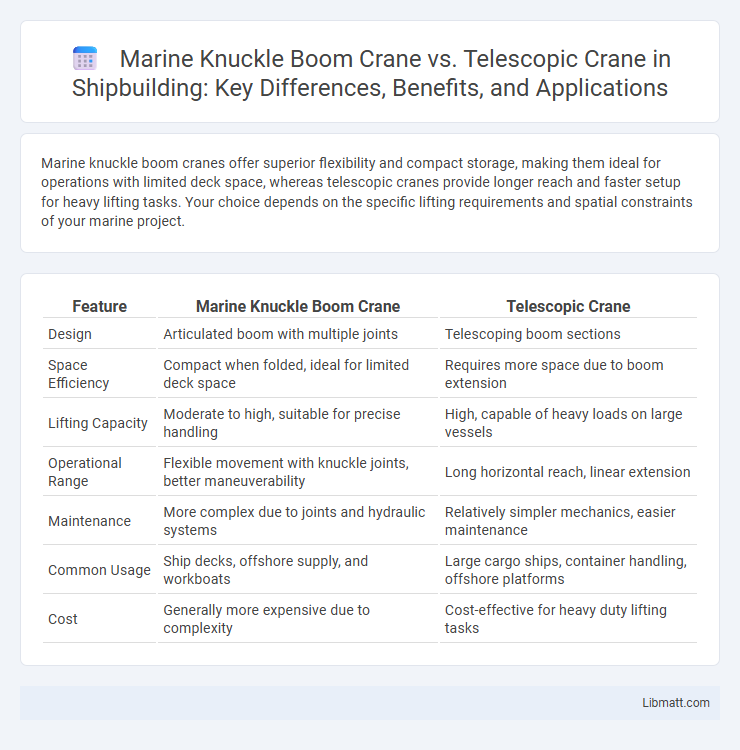Marine knuckle boom cranes offer superior flexibility and compact storage, making them ideal for operations with limited deck space, whereas telescopic cranes provide longer reach and faster setup for heavy lifting tasks. Your choice depends on the specific lifting requirements and spatial constraints of your marine project.
Table of Comparison
| Feature | Marine Knuckle Boom Crane | Telescopic Crane |
|---|---|---|
| Design | Articulated boom with multiple joints | Telescoping boom sections |
| Space Efficiency | Compact when folded, ideal for limited deck space | Requires more space due to boom extension |
| Lifting Capacity | Moderate to high, suitable for precise handling | High, capable of heavy loads on large vessels |
| Operational Range | Flexible movement with knuckle joints, better maneuverability | Long horizontal reach, linear extension |
| Maintenance | More complex due to joints and hydraulic systems | Relatively simpler mechanics, easier maintenance |
| Common Usage | Ship decks, offshore supply, and workboats | Large cargo ships, container handling, offshore platforms |
| Cost | Generally more expensive due to complexity | Cost-effective for heavy duty lifting tasks |
Introduction to Marine Knuckle Boom and Telescopic Cranes
Marine knuckle boom cranes feature articulated arms that provide exceptional maneuverability and precise load positioning, making them ideal for handling bulky or irregular cargo on vessels. Telescopic cranes utilize extendable boom sections that slide out to achieve variable reach and height, offering rapid deployment and versatility in confined maritime spaces. Both cranes are engineered to meet stringent marine standards, ensuring stability and safety during offshore lifting operations.
Key Design Differences
Marine knuckle boom cranes feature articulated arms with multiple joints, allowing for compact storage and enhanced maneuverability in tight shipboard spaces. Telescopic cranes utilize extendable boom sections that slide out in a straight line, providing longer reach and faster setup times. Your choice depends on space constraints and operational requirements, with knuckle boom cranes excelling in precision and telescopic cranes offering extended reach.
Lifting Capacity Comparison
Marine knuckle boom cranes typically offer higher lifting capacities at extended outreach compared to telescopic cranes, making them ideal for heavy-duty maritime applications. Telescopic cranes generally provide more compact storage and faster setup times but are limited in maximum load capacity relative to knuckle boom designs. Choosing between these cranes depends on specific operational requirements such as load weight, reach, and maneuverability on marine vessels.
Operational Flexibility and Reach
Marine knuckle boom cranes offer superior operational flexibility due to their articulated joints, allowing precise maneuvering in confined spaces onboard vessels. Telescopic cranes provide greater reach with extendable booms that can quickly adjust length to handle loads at varying distances. Depending on your maritime lifting needs, knuckle boom cranes excel in tight environments while telescopic cranes are ideal for extended reach tasks.
Safety Features and Standards
Marine knuckle boom cranes incorporate advanced safety features such as overload protection systems, anti-collision devices, and emergency stop functions, meeting stringent maritime safety standards like IMO and IMO MSC.1/Circ.1206 guidelines to ensure secure operations in harsh marine environments. Telescopic cranes are equipped with outriggers for stability, load moment indicators, and automatic limiters, adhering to ISO 11660 safety standards for offshore lifting equipment to prevent accidents during heavy lifts. Both crane types are designed to comply with SOLAS regulations, prioritizing operator safety and reliable load handling under dynamic sea conditions.
Space and Weight Considerations
Marine knuckle boom cranes offer superior space efficiency due to their compact design and articulated joints, allowing easier maneuverability in tight ship decks compared to telescopic cranes. Knuckle boom cranes typically weigh less while providing comparable lifting capacities, reducing overall vessel weight and improving stability. Telescopic cranes require more deck space when fully extended and usually have a heavier structural footprint, impacting ship design and weight distribution.
Maintenance and Durability
Marine knuckle boom cranes offer enhanced maintenance efficiency due to their articulated design, which allows easier access to hydraulic components and reduces wear on joints, ultimately extending service intervals. Telescopic cranes require rigorous upkeep of telescoping booms and hydraulic cylinders, which face higher exposure to corrosion and mechanical stress in marine environments. Both cranes utilize corrosion-resistant materials and coatings, but knuckle boom cranes generally demonstrate superior durability in harsh marine conditions by minimizing exposed moving parts and maximizing structural resilience.
Application Scenarios in Marine Environments
Marine knuckle boom cranes excel in confined spaces on vessels and offshore platforms due to their articulated arms, allowing precise load handling for cargo transfer, rescue operations, and maintenance tasks. Telescopic cranes are preferred for heavy lifting and extended reach requirements in open deck operations, shipbuilding, and offshore construction, offering rapid deployment and versatility with their extendable booms. Both crane types are essential in marine environments, optimized for stability, corrosion resistance, and operational safety under harsh sea conditions.
Cost-Effectiveness and Total Ownership
Marine knuckle boom cranes typically offer greater cost-effectiveness and lower total ownership expenses due to their compact design, reduced maintenance requirements, and enhanced fuel efficiency. Their ability to fold and stow easily minimizes deck space usage and improves vessel stability, which can lead to operational savings over time. When evaluating cranes for your marine operations, considering the lifecycle costs alongside initial investment is crucial for maximizing return on investment.
Choosing the Right Crane for Marine Operations
Marine knuckle boom cranes offer superior flexibility and compact storage, ideal for tight spaces on vessels and complex lifting tasks requiring precise maneuvering. Telescopic cranes provide extended reach and faster deployment, making them suitable for large-scale marine operations demanding heavy lifting over variable distances. Selecting the right crane depends on operational requirements such as load capacity, space constraints, and the specific marine environment where the equipment will be utilized.
Marine knuckle boom crane vs telescopic crane Infographic

 libmatt.com
libmatt.com